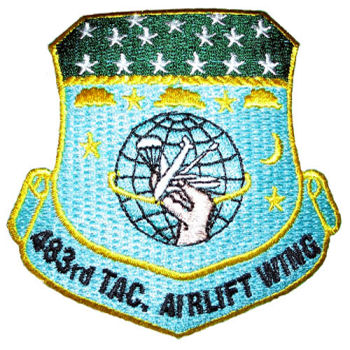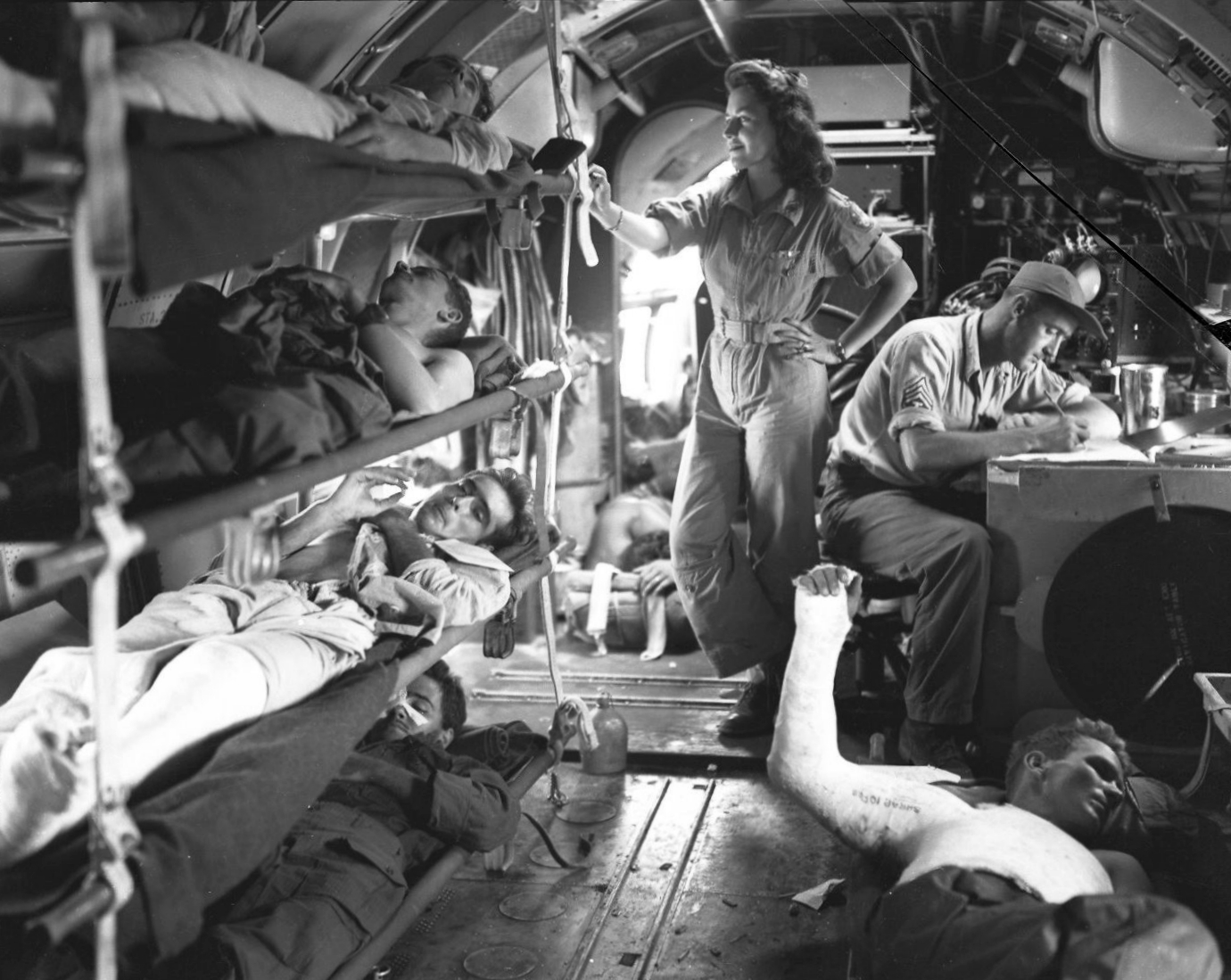|
537th Airlift Squadron
The 537th Airlift Squadron is an inactive squadron of the United States Air Force. The unit was last active at Joint Base Elmendorf-Richardson Alaska, where it was inactivated on 13 September 2013. The squadron was first established during World War II as the 537th Fighter Squadron. It served as a Replacement Training Unit for Republic P-47 Thunderbolt pilots until it was disbanded in a major reorganization of the Army Air Forces in 1944 designed to streamline training organizations. In 1952, the squadron was redesignated as the 537th Troop Carrier Squadron, and activated at Atterbury Air Force Base to replace elements of the 923d Reserve Training Wing. The following year the squadron was inactivated and replaced at Atterbury by the 73d Troop Carrier Squadron. The unit was activated again in Viet Nam as a C-7 Caribou squadron assigned to the 483d Tactical Airlift Wing the squadron was awarded three Presidential Unit Citations for its actions during the Viet Nam War. In ... [...More Info...] [...Related Items...] OR: [Wikipedia] [Google] [Baidu] |
Pacific Air Forces
Pacific Air Forces (PACAF) is a Major Command (MAJCOM) of the United States Air Force and is also the air component command of the United States Indo-Pacific Command (USINDOPACOM). PACAF is headquartered at Joint Base Pearl Harbor–Hickam (former Hickam AFB), Hawaii, and is one of two USAF MAJCOMs assigned outside the Continental United States, the other being the United States Air Forces in Europe – Air Forces Africa. Over the past sixty-five plus years, PACAF has been engaged in combat during the Korean and Vietnam Wars and Operations Desert Storm, Southern Watch, Northern Watch, Enduring Freedom and Iraqi Freedom. The mission of Pacific Air Forces is to provide ready air and space power to promote U.S. interests in the Asia-Pacific region during peacetime, through crisis, and in war. PACAF organizes, trains, and equips the 45,000 Total Force personnel of the Regular Air Force, the Air Force Reserve and the Air National Guard with the tools necessary to support the C ... [...More Info...] [...Related Items...] OR: [Wikipedia] [Google] [Baidu] |
483d Tactical Airlift Wing
The 483rd Tactical Airlift Wing was a tactical airlift and composite wing assigned to Pacific Air Forces during the Vietnam War. It was the host organization at Cam Ranh Bay Air Base South Vietnam from 1970–1972. The unit history includes the temporarily bestowed history of the World War II 483rd Bombardment Group, which was a United States Army Air Forces combat group. It served primarily in the Mediterranean, African, and The Middle East Theatres of World War II. During the Korean War, the group was redesignated the 483rd Troop Carrier Group and assigned to the wing. The Wing was first organized as the 483rd Troop Carrier Wing during the Korean War, as an airlift organization assigned to Far East Air Forces (later Pacific Air Forces) (PACAF) for duty. History Korean War The wing was activated at Ashiya AB, Japan as the 483rd Troop Carrier Wing on 1 January 1953 and replaced the 403rd Troop Carrier Wing, Medium and absorbed the 403rd's mission, personnel and equipment. ... [...More Info...] [...Related Items...] OR: [Wikipedia] [Google] [Baidu] |
DeHavilland Canada C-7A Caribou
The de Havilland Canada DHC-4 Caribou (designated by the United States military as the CV-2 and later C-7 Caribou) is a Canadian specialized cargo aircraft with short takeoff and landing (STOL) capability. The Caribou was first flown in 1958 and although mainly retired from military operations, is still in use in small numbers as a rugged "bush" aircraft. The design was further developed as the de Havilland Canada DHC-5 Buffalo, adding turboprop engines and other changes that further improved its short-field performance to the point where it competes with light aircraft even with a full load. Design and development The de Havilland Canada company's third STOL design was a big increase in size compared to its earlier DHC Beaver and DHC Otter, and was the first DHC design powered by two engines. The Caribou was similar in concept in that it was designed as a rugged STOL utility aircraft. The Caribou was primarily a military tactical transport that in commercial service fou ... [...More Info...] [...Related Items...] OR: [Wikipedia] [Google] [Baidu] |
434th Troop Carrier Group
434th may refer to: *434th Air Refueling Wing, one of the key refueling units in the US Air Force Reserve *434th Bombardment Squadron, an inactive United States Air Force unit *434th Fighter Training Squadron (434 FTS), part of the 47th Flying Training Wing based at Laughlin Air Force Base, Texas *434th Operations Group, an active United States Air Force Reserve unit See also *434 (number) *434 __NOTOC__ Year 434 ( CDXXXIV) was a common year starting on Monday (link will display the full calendar) of the Julian calendar. At the time, it was known as the Year of the Consulship of Aspar and Areobindus (or, less frequently, year 1187 '' ..., the year 434 (CDXXXIV) of the Julian calendar * 434 BC {{mil-unit-dis ... [...More Info...] [...Related Items...] OR: [Wikipedia] [Google] [Baidu] |
Curtiss C-46 Commando
The Curtiss C-46 Commando is a twin-engine transport aircraft derived from the Curtiss CW-20 pressurised high-altitude airliner design. Early press reports used the name "Condor III" but the Commando name was in use by early 1942 in company publicity. It was used as a military transport during World War II by the United States Army Air Forces and also the U.S. Navy/ Marine Corps, which called it R5C. The C-46 served in a similar role to its Douglas-built counterpart, the C-47 Skytrain, but it was not as extensively produced as the latter. After World War II, a few surplus C-46 aircraft were briefly used in their original role as passenger airliners but the glut of surplus C-47s dominated the marketplace and the C-46 was soon relegated to cargo duty. The type continued in U.S. Air Force service in a secondary role until 1968. The C-46 continues in operation as a rugged cargo transport for arctic and remote locations with its service life extended into the 21st century. Design ... [...More Info...] [...Related Items...] OR: [Wikipedia] [Google] [Baidu] |
Hobson Plan
The Hobson Plan was an organizational structure established by the United States Air Force (USAF) in 1948, following experimental organization in 1947. Known as the "Wing-Base Organization," it replaced the organization used by the United States Army Air Forces (AAF), the predecessor organization of the USAF, which used separate chains of command for combat and support units. The plan made the wing the basic combat unit of the AAF, rather than the group and placed all support elements on a base under the command of the wing commander in addition to combat elements. Background United States Army Air Forces As part of the United States Army, the operational units of the United States Army Air Forces (AAF) operated from facilities known as army air fields. They consisted of a ground station, which consisted of streets, buildings, barracks and the support facilities and organizations. The airfield consisted of the runways, taxiways, hangars, and other facilities used to support fl ... [...More Info...] [...Related Items...] OR: [Wikipedia] [Google] [Baidu] |
Camp Springs Army Air Field
Andrews Air Force Base (Andrews AFB, AAFB) is the airfield portion of Joint Base Andrews, which is under the jurisdiction of the United States Air Force. In 2009, Andrews Air Force Base merged with Naval Air Facility Washington to form Joint Base Andrews. Andrews, located near Morningside, Maryland in suburban Washington, D.C., is the home base of two Boeing VC-25A aircraft with the call sign Air Force One when the president is on board, that serve the President of the United States, and the President is typically flown in and out of Andrews when travelling from Washington, D.C. by plane. The host unit at Andrews is the 316th Wing, assigned to the Air Force District of Washington. It is responsible for maintaining emergency reaction rotary-wing airlift and other National Capital Region contingency response capabilities critical to national security and for organizing, training, equipping and deploying combat-ready forces for Air and Space Expeditionary Forces (AEFs). The 316 ... [...More Info...] [...Related Items...] OR: [Wikipedia] [Google] [Baidu] |
Millville Army Air Field
Millville Executive Airport is in Millville, in Cumberland County, New Jersey. The airport, southwest of the Millville city center, is owned by the Delaware River and Bay Authority (DRBA) and the City of Millville. It was dubbed "America's First Defense Airport" because of the nearly 1,500 pilots who trained in gunnery practice at the airport with the Republic P-47 "Thunderbolt" plane during World War II. Overview The airport is used for general aviation and is home to Dallas Airmotive, Cooper 1 Ambulance operated by Cooper University Hospital, Atlantic Air Ambulance, and PHI Helicopters. Facilities The airport covers at an elevation of 85 feet (26 m). It has two runways: 10/28 is 6,002 by 150 feet (1,829 x 46 m) asphalt and 14/32 is 5,057 by 150 feet (1,541 x 46 m) concrete. In 2010 the airport had 60,000 aircraft operations, average 164 per day: 95% general aviation and 5% military. 73 aircraft were then based at the airport: 78% single-engine, 12% multi-engine, 8% j ... [...More Info...] [...Related Items...] OR: [Wikipedia] [Google] [Baidu] |
Aircrew
Aircrew, also called flight crew, are personnel who operate an aircraft while in flight. The composition of a flight's crew depends on the type of aircraft, plus the flight's duration and purpose. Commercial aviation Flight deck positions In commercial aviation, the aircrew are called ''flight crew''. Some flight crew position names are derived from nautical terms and indicate a rank or command structure similar to that on ocean-going vessels, allowing for quick executive decision making during normal operations or emergency situations. Historical flightdeck positions include: * Captain, the pilot highest-ranking member or members of a flight crew. * First officer (FO, also called a co-pilot), another pilot who is normally seated to the right of the captain. (On helicopters, an FO is normally seated to the left of the captain, who occupies the right-hand seat).Smith, PatrickPatrick Smith's Ask The Pilot: When a Pilot Dies in Flight AskThePilot.com website, 2013, wh ... [...More Info...] [...Related Items...] OR: [Wikipedia] [Google] [Baidu] |






.jpg)